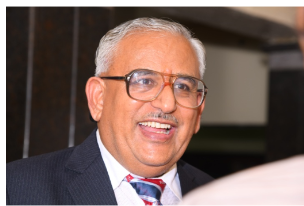Dr. BVK Sastry
Vak-Yogi, Vice-Chancellor, Yoga-Samskrutham University, Fl, USA
Digital Literacy and numeracy for Sanskrit is a pivotal concept first time introduced in 2020, through National Education Policy. The implementation plan is at schools, nationwide, target – beneficiary audience age group of 6 to 16. Many are getting first time introduced to Sanskrit studies through their mother tongue and first use of digital devices. The policy seems to seek a transformative educational process to shape a current (2021) school-student to be groomed as a Citizen (2030): Sanskrit-Digital literate. The ‘it’ in the policy expression ‘making it happen’, serves as ‘catch all – cover all’ phrase for this thinking. The teaching of Sanskrit will be no more in isolation! Sanskrit will become a natural part of a holistic multidisciplinary education, taking into account the local and global needs of the country. Sanskrit Literacy will remain a hallmark of national pride, self-confidence, scientific thinking, social inclusion, self-knowledge, community-cooperation, yoga-spirituality and integration.
Sanskrit: Literacy to ‘Digital Literacy’: a new dimension to classical norms and ‘creativity part in learning and teaching’ at school-student-teacher.
Digital literacy provides ‘digital keying skill’ as an extension of (hand+writing+ operation) classical literacy skill. This is necessary to work with language data in digital document formats. Edtech has modified ‘human teacher dominated in-person class room to asynchronous off line mode where digital literacy is a critical skill. The current digital infrastructure (devices, apps, keyboards and interfaces) is ‘not naturally tuned and designed for needs of non-English Indic scripts, more specifically for Brahmi Indic Devanagari model. This is causing a steep learning curve in adapting STS and SSS syllabus models in native language mother tongue natural mode, without recourse to anglicised base for teaching in schools. For the syllabus part, there is a transition needed from pre-2020 period text-syllabus-teaching-evaluation models, currently in vogue. The previous syllabus were tailor crafted for classroom – Sanskrit medium – in person teaching. The new model of NEP – appropriate syllabus needs to find a way to balance the total achievement of literacy in classical and digital frame works. Policy has good pointers and guidelines to address above challenges and overcome digital divides and imbalances.
Implementation Challenges? Digital Sanskrit literacy at school level is different from ‘using indic devanagari script’ on given digital device and infrastructure of OS and applications to generate a screen visual display document and useful for formatted print-ready document generation. The entangled questions in ‘school level digital literacy’ are pedagogy and methods to:
- train first time Sanskrit language learners at school
- exposed mainly to mother tongue (and partially basic English)
- who get first time exposure to access digital devices and online media
- goal is to learn school syllabus content in a less formal, non-class room set up with partial assistance from teachers/ parents
- where medium of instruction is not necessarily Sanskrit
This calls for a new thinking on education pedagogy and digital infrastructure that suits the expectation of SSS and STS needs. The systems to deliver Sanskrit digital literacy has to stand on its own brahmi natural language status and merits. English can be / need to be accommodated and will surely be done. The design and plan to deliver ‘Digital Sanskrit literacy’ in indic scripts cannot / should not end up promoting English as essential first base to learn –use – Indian languages – Devanagari by screen character display with anglicised voices over digital devices.
Digital Sanskrit Literate: Expectation
The expectation from the syllabus for this program, spanning a schooling duration of 5 to 8 years is to acquaint the student with foundational skills in two blocks,
- Generic skills: Acquaintance, appreciation and connections that integrate Sanskrit as a part and parcel of bharateeya culture, heritage, religion, practices and languages: a common minimum base, aimed to instil a deep-rooted pride in being Indian, not only in thought, but also in spirit, intellect and ethos. This provides a practical utility for good ethical living and serve a source of knowledge -advancement.
- Prepare ground for exploring advanced skills: needed to build a good foundation for future pursuit of advanced studies, higher education initiatives through research and scholarly pursuits in ‘bharateeya samskruti’ in domains of culture, history, source texts and languages of religions, sciences and Sanskrit Knowledge Systems.
Conclusion: Making NEP-2020 happen for Sanskrit: Digital literacy and numeracy is a very important step to realise the vision of ‘Ek Bharat Shrestha Bharat’ initiative and emerge as ‘Atma-nirbhar Viswa-guru’. Sanskrit needs to be presented in public education system, in its true role of language, which has shaped the bharateeya identity of India, served as an integrating language of culture, science and spirituality. There are stigma –tags and negative auras that need to be cleared for ‘Sanskrit’ through NEP syllabus. The power of Paninian rules for programming digital devices needs to be tapped. In this sense, NEP initiative has given a fillip to revisit Sanskrit related language technologies and groom future citizens who need to benefit from e-governance using techno-linguistic Indic script solutions through A.I, IoT in the areas of Health care, Social media, banking and education. The initiative is a new opening to realise the ‘Panini Machine’ dream of 2020 for as an extended implementation of wish ‘Sanskrit is best suited language for programming computers’ made in 1984.



